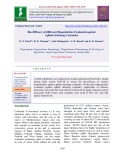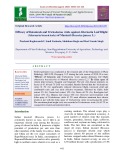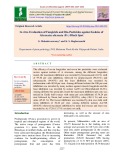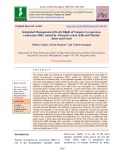
Garlic bulb extract
-
A field experiment was conducted at Anand Agricultural University, Anand during Rabi season 2019-20 to assess the bio-efficacy of various biopesticides against aphids infesting coriander. Of the nine biopesticides evaluated against aphids infesting coriander, application of tobacco decoction was found the most effective followed by ginger rhizome extract and garlic bulb extract with coriander seed yield of 449, 437, and 420 kg/ha, respectively.
 10p
10p  cothumenhmong11
cothumenhmong11
 11-05-2021
11-05-2021
 12
12
 2
2
 Download
Download
-
The incidence and severity of Alternaria blight in rapeseed-mustard fields is greatly influenced by temperature, relative humidity, soil condition at the time of planting, splashing rain, wind velocity, leaf wetness and inoculum density available in the soil (Meena et al., 2004).
 6p
6p  trinhthamhodang11
trinhthamhodang11
 27-04-2021
27-04-2021
 11
11
 1
1
 Download
Download
-
A field experiment was conducted at the research plot of the Department of Plant Pathology, SHIATS, Allahabad, U.P. during the Rabi season of 2013-14 to evaluate selected bioagents, plant extracts and fungicides for the management of Alternaria blight of Indian mustard (Brassica juncea L.) by applying foliar sprays of certain fungicides plant extract and bio-agents. Per cent disease intensity on leaves at 75 DAS, per cent Alternaria pod blight at 90 DAS, test weight (g/1000 seeds) and yield (q/ha) were recorded.
 6p
6p  kethamoi6
kethamoi6
 29-06-2020
29-06-2020
 16
16
 1
1
 Download
Download
-
Among seven bio-pesticides evaluated against A. craccivora on fenugreek, azadirachtin 0.0006%, neem oil 0.3% and garlic bulb extract 3% were found most effective in suppressing the aphid population. Maximum seed yield was registered in plots treated with azadirachtin followed by neem oil and garlic bulb extract. The maximum net realization was obtain in the treatment of azadirachtin and maximum ICBR was registered in neem oil 0.3%.
 7p
7p  angicungduoc5
angicungduoc5
 12-06-2020
12-06-2020
 18
18
 1
1
 Download
Download
-
A field experiment was conducted to study the bio efficacy of seven plant extracts viz., neem oil 0.3%, neem seed kernel extract 5%, azadirachtin 0.15 EC 0.0006%, Aloe vera extract 1%, Citrulluscolo cynthis leaf extract 1%, garlic bulb extract 3% and neem leaf extract 10% against fruit borers during summer and kharif, 2016 at Main Vegetable Research Station, Anand Agricultural University, Anand (Gujarat).
 8p
8p  kequaidan4
kequaidan4
 05-05-2020
05-05-2020
 7
7
 0
0
 Download
Download
-
Laboratory studies were conducted to study the effect of six botanicals (neem leaf extract, garlic bulb extract, eucalyptus leaf extract, castor oil, mustard oil, neem oil) and two bio products (vermin wash, cow urine) were evaluated against against A. cucumerina var. cyamopsidis under in-vitro condition.
 11p
11p  trinhthamhodang1212
trinhthamhodang1212
 06-04-2020
06-04-2020
 12
12
 0
0
 Download
Download
-
The efficacy of seven fungicides and seven bio pesticides were evaluated invitro against isolates of A. alternata, among the different fungicides tested, the maximum inhibition was recorded by hexaconazole (0.1%) with of 97.84 per cent inhibition, followed by propiconazole (96.31%) and tebuconazole (94.45%) and the least inhibition was recorded by carbenazime with 40.94 per cent. Among different isolates the 100 per cent inhibition was recorded by many isolates against triazole fungicides and the least inhibition was recorded by isolate Aa353 on Chlorothalonil (0.2%).
 8p
8p  nguathienthan3
nguathienthan3
 27-02-2020
27-02-2020
 22
22
 0
0
 Download
Download
-
The present study was carried out to find the integrated management of early blight of tomato (Lycopersicon esculentum Mill.) caused by Alternaria solani. Tomato (Lycopersicon esculentum Mill.) is an important vegetable crop which is grown all over the world. Early blight of tomato, caused by Alternaria solani is one of the most important diseases in tomato. Two fungicides i.e. Mancozeb 75 WP and Hexaconazole 5 EC at different concentrations (0.1%, 0.2% and 0.3%), two bio-agents viz., Trichoderma harzianum and T. koningii and two botanicals i.e.
 9p
9p  nguathienthan2
nguathienthan2
 26-12-2019
26-12-2019
 14
14
 0
0
 Download
Download
-
A field experiment was conducted to evaluate the effect of bioagents and botanicals in vivo during kharif, 2017 to manage anthracnose caused by Colletotrichum capsici on chilli (Capsicum annuum L.).The anthracnose of chilli is one of the most devastating diseases. The various factors viz. nutritional, physical and toxicological factor showed wide variation on growth and sporulation of C. capsici. The effect of treatments on anthracnose disease management of chilli in field condition revealed that all the treatments showed significant reduction in the intensity and over control.
 8p
8p  cothumenhmong1
cothumenhmong1
 08-12-2019
08-12-2019
 15
15
 1
1
 Download
Download
-
Corynespora leaf fall (CLF) disease of rubber incited by Corynespora cassiicola is listed as a fourth most serious leaf disease of rubber in South East Asia. As the rubber is a tree crop it grows up to 60 – 70 feet height, management of this disease is not easy and it involves more price tag. The use of effective and economical management strategies is plays a vital role in efficient disease management in rubber plantations. To develop a tool to integrated disease management approach, tested different bio-agents, plant extracts and fungicides against Corynespora cassiicola.
 8p
8p  cothumenhmong1
cothumenhmong1
 08-12-2019
08-12-2019
 11
11
 0
0
 Download
Download
-
Garlic (Allium sativam L.) is the second important bulb crop after onion. It is very hardy vegetable crop and is grown throughout India. It reduces the cholesterol in the blood. The garlic extracts also the nematicidal fungicidal and bacterial properties. Garlic is in flavorings food, preparing chutneys, pickles, curry powder, tomato ketchup etc. It is rich in proteins, phosphorus, calcium, magnesium and carbohydrates. China rank 1st in area and production (7.79 lakh ha and 179.68 lakh MT, respectively) and India is the second in area (2.05 lakh ha) and production (10.70 lakh MT).
 7p
7p  nguaconbaynhay1
nguaconbaynhay1
 04-12-2019
04-12-2019
 16
16
 0
0
 Download
Download
-
A study was conducted in vitro to control Colletotrichum dematium causing anthracnose disease of groundnut with Trichoderma harzianum and botanicals. Five botanicals viz., Datura leaf extract, Tulsi leaf extract, Garlic bulb extract, Neem oil and Eucalyptus oil at the rate of 5% were evaluated for their efficacy against the radial colony growth of C. dematium. The complete inhibition was obtained in Eucalyptus oil (100%) followed by T. harzianum (71.01%), datura leaf extract (64.78%), tulsi leaf extract (63.63%), neem oil (49.14%) and garlic bulb extract (43.35%).
 7p
7p  nguaconbaynhay1
nguaconbaynhay1
 04-12-2019
04-12-2019
 14
14
 0
0
 Download
Download
CHỦ ĐỀ BẠN MUỐN TÌM













![Utilization of plant extracts for managing fruit borers in okra, [Abelmoschus esculentus (L.) Moench] Utilization of plant extracts for managing fruit borers in okra, [Abelmoschus esculentus (L.) Moench]](https://tailieu.vn/image/document/thumbnail/2020/20200505/kequaidan4/135x160/2671588668053.jpg)




![Evaluation of different fungi toxicants against Corynespora Cassiicola causing corynespora leaf fall (CLF) disease of rubber [Hevea brasiliensis Muell. Arg.,] Evaluation of different fungi toxicants against Corynespora Cassiicola causing corynespora leaf fall (CLF) disease of rubber [Hevea brasiliensis Muell. Arg.,]](https://tailieu.vn/image/document/thumbnail/2019/20191208/cothumenhmong1/135x160/451575821464.jpg)






